9 Wood Species Best for Outdoor Projects
Expert Roundup: 9 Wood Species Best for outdoor projects
There are many types of outdoor furniture made of materials such as wicker, metal, stone, and concrete. Whatever your preference, there are a multitude of materials available to fit your needs. In this article we won't go over all of the different types, because, well, I would probably bore you and it would be a ridiculously long page. But, this article will go over the most popular materials and how to prepare it for a long lasting life. When speaking about outdoor furniture, imagine any type of furniture you'd find on a porch, patio, or backyard. Wood is a great choice of material for projects such as patio sets, porch swings, and tree houses. But did you know that not all wood is good for outdoor use? There are a variety of species out there, but only a select few make great wooden outdoor furniture. So what makes some wood species better for outdoor use than others? Well, there are species of wood that rot slower than others, like Black Locust and Bois D'Arc. These woods have physical barriers that prevent moisture from penetrating the wood, called tyloses. Tyloses also block insects and organisms from penetrating the wood. When working with wood for outdoor projects, I recommend using heartwood rather than its sapwood. Heartwood is the stronger, inner-most wood of the tree; which often consists of the majority of a stem's cross-section. Sapwood is light in color and the living, outermost segment of a stem or branch. I talked to expert woodworkers, furniture finishers, and craft woodworking artists to get the scoop on their outdoor furniture material preferences. The following list of wood species (in alphabetical order) is their go-to wood species for outdoor furniture projects, and can be yours too.
Wood for Outdoor Furniture:
1. Acacia
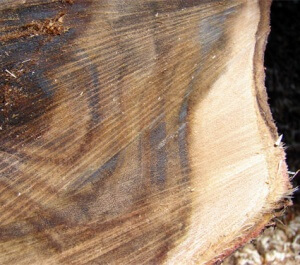
Acacia is a thick, strong hardwood with high oil content. This hardwood is resistant to the elements, rotting and insects. Acacia is very abundant, making it one of the more affordable options. James Armstrong, a woodworking consultant from Wood Blinds Direct, says "if you're thinking about the environmental impact of your wooden furniture, you should go with a fast-growing hardwood, like acacia. It's durable, and resists the elements well (and is often used in boat-building for its abundance and resistance to water). Once sealed, acacia is a rich, dark, golden brown." If left unsealed, it can discolor if it is regularly exposed to water. With that being said, I advise to keep acacia furniture off the grass or ground as it will have a tendency to absorb moisture.
2. Black Locust
Black Locust is one of the strongest and stiffest domestic woods. It competes with Hickory for the title of strongest, but has more stability and rot resistance. This makes it very durable with good weathering characteristics. Black Locust is moderately easy to work with. The Wood Database states "Overall working characteristics for Black Locust are mixed: although the grain is usually straight, its high density and hardness can make it difficult to machine. Black Locust also has a moderate blunting effect on cutting edges. Responds very well to both lathe turning and steam bending; glues and finishes well." This can be an affordable wood with great uniform patterns to use for making tables or benches.
Jacob Aune is familiar with Black Locust. "Its decay resistance is notable enough to be mentioned in a study by the Louisiana State University on wood decay prevention. Because of its exceptional strength, this is the species to use in outdoor applications where structural integrity is important. It is tougher than white oak and also offers better longevity in outdoor environments." Aune is the owner of Altare Design, a custom woodworking service based in South Chicagoland near Kankakee, Illinois.
3. Cedar
Cedar is soft, light, and easy to work with. A drawback of working with cedar is the fact that it has poor screw-holding capabilities because of the overall softness of the wood. Although, it does make good outdoor furniture because it's rot, termite, and Powder Beetle resistant. Aune says most of the ones native to North America offer excellent resistance to rot and most insects. Commonly used for fences, roofing and siding: Cedar can last for years without any maintenance or treatment. On the negative side, it is much softer and more brittle than the other species on this list with the exception of cypress.
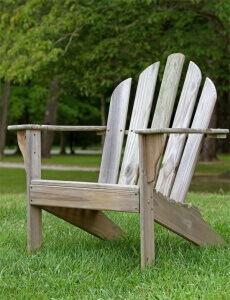
Armstrong pointed out that the natural resins in cedar are what make it such a hardy timber, and very useful for outdoor furniture. It doesn't need to be painted, stained or treated, but doing so will enhance the lifetime of the wood against the elements. If left untreated, it weathers to a gray color. Since cedar is a softer, lighter, faster growing wood, it won't last as long as hardwood. Ken Schumacher, a professional woodworker and owner of KS WoodCraft (a company that specializes in building custom furniture), has a great example of how insect resistant cedar is: "A few years back, I was a tabletop source for a major national furniture company. The company loved ordering live edge aromatic cedar tops from us. When the raw slabs arrived to our shop, we noticed that there were tiny insects boring in the bark of the slabs. What must have happened is that the slabs were placed out in the yard after the kiln treatment. The insects must have found shelter in the bark of the wood, but did not penetrate the heartwood AND sapwood."
4. Cypress
Cypress wood is rot and insect resistant attributable to its natural oils. Cypress weathers to a silver gray over time if left unfinished, similar to cedar, and has enough oil content to resist water and rot for a while. The wood is comparable in softness to the various cedars. The cypress heartwood color varies from a light yellow brown, to reddish and dark brown. Aune says "old growth wood has the best reputation. While the wood commercially harvested these days may not be as highly regarded, it is still a viable wood for outdoor use." So what makes cypress a great option for outdoor furniture? "Cypress, despite being a softer wood, is still a great option for making outdoor furniture, because it's a light wood with pretty grain pattern, which makes a great visual impact. Because of its lighter color and gorgeous grain, your choice of stain will really pop once cypress wood has been coated. Cypress is a very pretty option for those who are keen on making their garden furniture stand out" says Armstrong. Cypress stains very well.

KS Woodcraft builds a lot of furniture with cypress. Schumacher states "while being a very light [referring to weight] wood, it remains quite stable. In all of our applications, we find that there is minimal movement; which we LOVE. Special care should be taken when planing "" small passes to remove tear out." Planing refers to the process of flattening, smoothing, and shaping a rough piece of wood with a tool called a plane.
5. Douglas-Fir
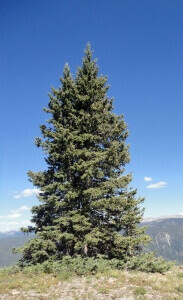 Douglas-fir is widely available and used predominately for construction and building projects. This species is one of the hardest softwoods commercially available in the U.S. Its heartwood is moderately strong in regard to decay, but is vulnerable to insects. Douglas-fir is relatively easy to work with. Staining and finishing it is easy. It holds adhesives well too. You may be familiar with this species already if you celebrate Christmas. Douglas-fir is a popular type of Christmas tree! Bruce Lemler says douglas-fir offers "great wood character in terms of grain and texture while providing a strength, sturdiness and hardiness that performs incredibly well for everything from outdoor patio sets and benches to tree houses and sheds. Add to that the versatility for finishing and you've got your wood. Whether clear varnish, stain or paint achieves the final desired appearance, this wood will look great. Seek out Douglas-fir that's been weather-treated, and you're already ahead of the game." Bruce Lemer is a woodworker, owner of ARTwood, and self-proclaimed "Lumberjock", so he knows outdoor wood. ARTwood specializes in creating wood furnishings from reclaimed wood (mainly trees felled by Hurricane Sandy) but also furnishings in need of rescue.
Douglas-fir is widely available and used predominately for construction and building projects. This species is one of the hardest softwoods commercially available in the U.S. Its heartwood is moderately strong in regard to decay, but is vulnerable to insects. Douglas-fir is relatively easy to work with. Staining and finishing it is easy. It holds adhesives well too. You may be familiar with this species already if you celebrate Christmas. Douglas-fir is a popular type of Christmas tree! Bruce Lemler says douglas-fir offers "great wood character in terms of grain and texture while providing a strength, sturdiness and hardiness that performs incredibly well for everything from outdoor patio sets and benches to tree houses and sheds. Add to that the versatility for finishing and you've got your wood. Whether clear varnish, stain or paint achieves the final desired appearance, this wood will look great. Seek out Douglas-fir that's been weather-treated, and you're already ahead of the game." Bruce Lemer is a woodworker, owner of ARTwood, and self-proclaimed "Lumberjock", so he knows outdoor wood. ARTwood specializes in creating wood furnishings from reclaimed wood (mainly trees felled by Hurricane Sandy) but also furnishings in need of rescue.
6. Ipe

Ipe is a fast growing wood imported from Central and South America. It is a really hard and dense timber. The high density found in ipe means it can barely float. It also means it is a more difficult wood to work with, so monitor your cutting edges carefully when working with ipe as you will experience a high cutting resistance. Ipe can be a difficult wood to glue properly. It is recommended to prepare the surface prior to gluing. I would stay away from using adhesives on ipe if you can help it. Aune from Altare Design agrees. He says "A word of warning for those using ipe: it also resists many adhesives. This makes it a poor choice for furnishings that rely upon glue for structural integrity. Mechanical fasteners such as screws or interlocking wood joints are the safer option." On the plus side, some experts say ipe can last as long as 40 years if left untreated. I would give it about 15 years if left untreated and in an outdoor setting. It resists movement, warping, cracking, decomposition, and denting. Aune says "this is a very hard wood so it will resist physical damage better than the rest of the species mentioned here. It is also highly resistant to insects and fungi thanks to its oil and extractive content. This makes ipe the ideal wood for outdoor uses that will subject it to heavy abuse such as flooring for decks and gazebos. It's commonly sold for decking because of its weather-resistance and extreme density. For an outdoor wood that needs to be resistant to dents and scratches, this is the one."
7. Redwood
 Redwood is most commonly used in outdoor furniture due to its natural insect and moisture resistant qualities. Redwood's structure has little pitch and resin, so it holds finishes extremely well. This wood is not for the ecologically minded though, since redwood trees grow slowly and are in limited supply. Redwood is more of an extravagant wood for its fine qualities and can be an expensive lumber to source. Schumacher agrees: "A popular wood from the West, redwood is a well-liked choice for live edge furniture and any project that requires a nice wide board. Much like cedar, we rarely use redwood due to the fact that it is a soft wood and susceptible to dents, dings and chips. Like cypress, tear-out can occur when machining redwood. It is a very beautiful wood and cuts very well "" there is also very minimal movement!"
Redwood is most commonly used in outdoor furniture due to its natural insect and moisture resistant qualities. Redwood's structure has little pitch and resin, so it holds finishes extremely well. This wood is not for the ecologically minded though, since redwood trees grow slowly and are in limited supply. Redwood is more of an extravagant wood for its fine qualities and can be an expensive lumber to source. Schumacher agrees: "A popular wood from the West, redwood is a well-liked choice for live edge furniture and any project that requires a nice wide board. Much like cedar, we rarely use redwood due to the fact that it is a soft wood and susceptible to dents, dings and chips. Like cypress, tear-out can occur when machining redwood. It is a very beautiful wood and cuts very well "" there is also very minimal movement!"
8. Teak
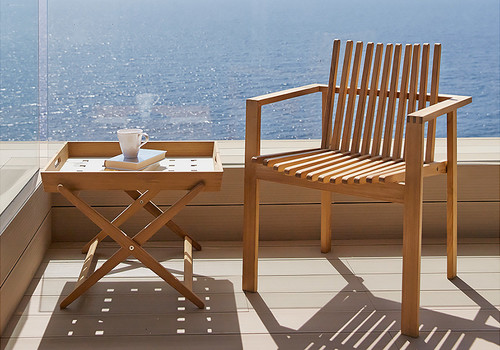 Contemporary outdoor lounge chairs
Contemporary outdoor lounge chairs
Teak is the king of durable, outdoor woods. It's extremely rot resistant, reasonably dense and straight-grained, will not warp or crack over time, and has an attractive appearance. Teak is chiefly associated with boatbuilding. It is on the expensive side at roughly $20 per square foot of 1" thick material, but it makes an excellent choice for small outdoor projects. "Teak will darken over time, but, like a good wine, it only gets better as it ages" says Schumacher. The resistance to rot and insects is a popular attribute of teak in the expert community. Jacob Aune says, "This species of wood contains natural oils that act as water repellent and extractives that deter some insects. It also has good stability which means it does not shrink or expand as much as many other woods when exposed to humidity changes. Less shrinking and swelling means there's less likelihood of cracks forming on the wood surface. Cracks tend to attract and retain moisture. Excessive moisture increases the risk of insect and fungi damage." Teak is a personal favorite of the folks at Wood Blinds Direct. James Armstrong says it's because it won't swell or split, even in the wettest of climates; it'll last for decades. He advises that "it does require a yearly coat of oil if you want it to maintain its light golden color. Most teak available is not sourced from sustainable plantations, although it is a premium choice, and is priced accordingly." Ken Tomita, co-founder of Grovemade and former furniture maker, knows his teak. "It machines and cuts beautifully with almost a buttery texture when you work with it. There are two fundamentally different ways to think about the use of teak. One is to use teak oil to give it a beautiful buttery luster. The drawback here is it requires constant maintenance through re-oiling. The other is to leave it unfinished and let it turn grey as the sun's UV takes out the color. This way requires little to no maintenance and you let nature do what it will do. Which method you choose is purely a matter of personal preference; to each their own!" Grovemade hand crafts consumer goods from all natural materials. Prior to Grovemade, Tomita spent several years in the furniture making business.
 There is some controversy associated with teak due to exploitation. It's often associated with the destruction of sensitive rain forests. Tomita says "It is important to consider the environmental impacts of your wood choices and look for certified sustainable forested teak." The scarcity of true teak has brought people to find ways to imitate it using other woods. Aune elaborates: "It is important to be aware that many products marketed as teak are not genuine teak. Look for genuine Burmese teak or genuine plantation-grown teak. For example, Rhodesian teak and Brazilian teak is a different species despite the use of the teak moniker." Schumacher agrees, "True Teak is rare, which makes it VERY expensive. A choice that we often lean towards is Iroko or Ipe, which has similar qualities and is reasonably priced. The Teak furniture comes with a higher price tag, but I feel that the wood is superior." If you are interested in being ecologically friendly, consider buying wood from forests certified by the Forest Stewardship Council. The FSC is a non-profit organization that promotes environmentally sound, socially beneficial and economically prosperous management of the world's forests.
There is some controversy associated with teak due to exploitation. It's often associated with the destruction of sensitive rain forests. Tomita says "It is important to consider the environmental impacts of your wood choices and look for certified sustainable forested teak." The scarcity of true teak has brought people to find ways to imitate it using other woods. Aune elaborates: "It is important to be aware that many products marketed as teak are not genuine teak. Look for genuine Burmese teak or genuine plantation-grown teak. For example, Rhodesian teak and Brazilian teak is a different species despite the use of the teak moniker." Schumacher agrees, "True Teak is rare, which makes it VERY expensive. A choice that we often lean towards is Iroko or Ipe, which has similar qualities and is reasonably priced. The Teak furniture comes with a higher price tag, but I feel that the wood is superior." If you are interested in being ecologically friendly, consider buying wood from forests certified by the Forest Stewardship Council. The FSC is a non-profit organization that promotes environmentally sound, socially beneficial and economically prosperous management of the world's forests.
9. White Oak
White oak is Jacob Aune's personal favorite for making furniture since it is much stronger and harder than the others and is considered desirable for all types of furniture, indoors or out. It is abundant and can be bought in a wide range of widths and thicknesses. It's rot-resistant, and easy to work with. "With its straight grain and natural resistance to rot, regularly stained and well looked-after white oak furniture can last for decades" says Armstrong speaking from experience. White oak is widely used in cabinet and furniture making as well as in flooring, boat building, barrels, interior trim and veneer. It doesn't have the oil content of teak or ipe and should be painted or protected with a water-resistant sealer or topcoat. This requires extra effort in maintenance but the cost savings are significant. Teak can easily cost five times as much as a good grade of white oak. 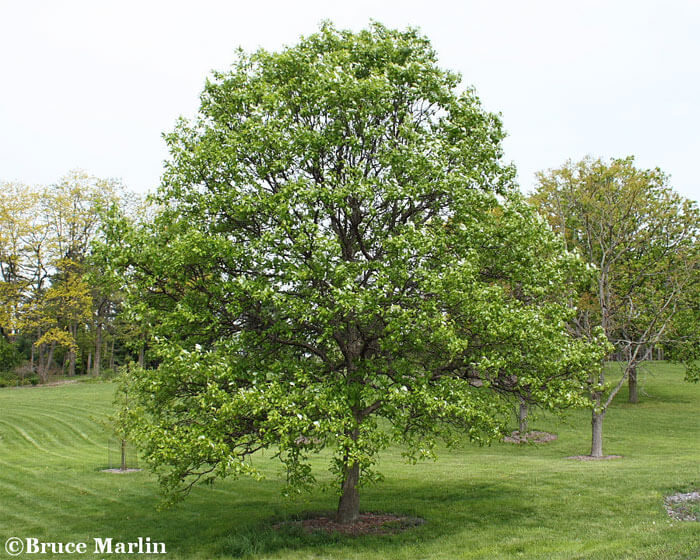 "It has a long history of use in boat-making (including old English war ships) and barrel-making thanks to its water-proof characteristics. Be sure to avoid using red oak as that wood is very porous and will not resist water the way white oak does. It is also a good idea to take notice of what species are preferred by modern boat builders. While it has plenty of extractives, it does not have natural oils so it is not nearly as enduring of the outdoors as teak or ipe. What it does have going for it is the presence of tyloses - a type of cellular growth that fills the pores of the wood. This prevents water from being able to penetrate the wood and this is one reason why this species has been a favorite in building warships and water and whisky barrels" says Aune. Schumacher believes white oak is a very stable wood, "worthy of the outdoors if finished properly." He began to trust white oak more for outdoor projects when he started to buy reclaimed wood. "I am partial to white oak due to the fact that I can truly color the wood at my discretion which adds a creative element to the piece. I was amazed by the fact that hundreds of century-old barns and school houses had white oak exteriors. The wood arrives to my shop in fantastic shape "" ready to start its second life" says Schumacher.
"It has a long history of use in boat-making (including old English war ships) and barrel-making thanks to its water-proof characteristics. Be sure to avoid using red oak as that wood is very porous and will not resist water the way white oak does. It is also a good idea to take notice of what species are preferred by modern boat builders. While it has plenty of extractives, it does not have natural oils so it is not nearly as enduring of the outdoors as teak or ipe. What it does have going for it is the presence of tyloses - a type of cellular growth that fills the pores of the wood. This prevents water from being able to penetrate the wood and this is one reason why this species has been a favorite in building warships and water and whisky barrels" says Aune. Schumacher believes white oak is a very stable wood, "worthy of the outdoors if finished properly." He began to trust white oak more for outdoor projects when he started to buy reclaimed wood. "I am partial to white oak due to the fact that I can truly color the wood at my discretion which adds a creative element to the piece. I was amazed by the fact that hundreds of century-old barns and school houses had white oak exteriors. The wood arrives to my shop in fantastic shape "" ready to start its second life" says Schumacher.
So Which Wood Type Lasts the Longest Outdoors? The general consensus is for hardwoods, such as ipe and teak. Since these species are extremely rot-resistant and durable, they have the best chance at a long life outdoors. These hardwoods are very durable and can last decades with minimal maintenance. Anything wood outdoors is going to degrade over time, says Ken Tomita. His preference is to use natural oil finishes that can be replenished. "If people use plastic clear coats they will eventually yellow and start peeling off and are un-repairable besides sanding it off and starting over. In general, the only way to protect any wood furniture from the elements is to leave it out of the elements as much as you can."
Wood Maintenance Tips from the Experts:
- Wooden outdoor furniture is fairly easy to maintain. At the start of spring, give it a good clean with some soapy water. If it's really filthy, a quick pass with some sand paper will see it looking like new (although we don't really think that's needed in most cases). And then apply a couple of coats of your chosen wood stain, or paint, to help protect it from the elements and any pests. Some people let their wooden outdoor furniture age naturally, so that it starts to look silver, which can be very attractive. But personally we prefer a rich golden brown color; stain once per year to get this effect. "" James Armstrong
- Applying an all-weather varnish such as BEHR Premium Transparent Weatherproofing All-In-One Wood Finish, (applied immediately upon purchasing or finishing your outdoor pieces) with a repeat application in Spring every 2-3 years goes a long way. Each application should involve two coatsa regular coating, then a second, thinner coating for good measure. It'll literally seal up the wood from outdoor elements including UV light, rain, snow, wind, hail, you name it! "" Bruce Lemler
Choosing the right wood species reduces the need for maintenance but that does not mean regular care won't extend the life of furnishings or improve the appearance. All furnishings should be given an occasional cleaning to get rid of dirt and grime. A dilute solution of Murphy's oil soap and water works well. Use a damp rag or sponge to do the cleaning and then repeat the process with fresh water to rinse the soap off. There are people out there who will warn against the use of oil soap with the claim it interferes with refinishing but that is untrue. Aune has personally used this process as a preliminary cleaning prior to refinishing and have never had a problem while applying the new finish. Silicone-based cleaners and polishes are the culprits so avoid those. Do not soak the furniture or flood it with water while cleaning. As someone that does restoration and repair work, I seldom get a call from someone telling me how great their furniture looks after decades. People do call when they need something fixed and that provides great insight on where problems begin. The most severe damage occurs from direct sunlight, melting snow and ice or standing water. In general, furnishings should be protected from direct rain, snow and sunshine to extend their usefulness. UV rays break down all woods eventually and excessive moisture is a requirement for the fungi, mold and insects that break down wood. It is best to keep some sort of moisture barrier between wood furniture and the ground since water will wick up from the soil. Never attempt to dry wood artificially with heat or forced air. While moisture can cause damage, rapidly drying it is even worse because the sudden change causes the wood to shrink unevenly. This can cause cracks to develop. If possible, it is best to bring wood furniture indoors for the winter. Melting snow sitting on wood will keep it damp for weeks on end. The freeze/thaw cycle can also damage joints and loosen screws. Do not simply drape the wood with plastic since dew can form underneath and cannot evaporate quickly enough for the wood to dry. Canvas would get wet and keep the furniture soggy. Lastly, a water-proof topcoat will extend the life of any furnishings. My personal favorite is Le Tonkinois (available from American Rope and Tar) even though it lacks UV-inhibitors. It applies easily with a brush, is water-proof and holds up better than most of the spar varnishes available at the typical home improvement center. This is the finish used on my personal pair of wooden sunglasses which are kept in the car 24/7. They are still in great condition after more than a year of Midwest seasonal changes and that is a harsh environment! "" Jacob Aune There you have it. This list should get your research process off the ground when considering which wood species are best for wooden outdoor furniture. Have something to say? Don't hesitate, comment below.
Find us on Facebook By: Luis Leonzo | Follow me on Google+
